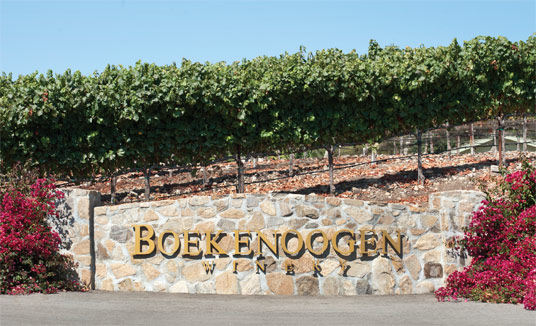
Like many young men in the 1850s, George Boekenoogen packed his hopes and dreams into a covered wagon and headed west in search of gold. Prospecting did not pan out for the dogged Dutchman, so he moved to the fertile foothills of the Salinas Valley, where he started a family legacy around row crops and cattle. George’s great-grandson, John Boekenoogen, followed in those footsteps. He spent his days punching cows, driving tractors, eating dust and praying to the fickle farm gods, until one day in 1995 he caught a glimpse of himself in his truck’s rearview mirror.
“I looked old,” he says. “Older than I should have.” during this time Boekenoogen received three brokered offers to buy the family property. He would never sell, but his research showed that all three offers came from large wineries. Out of the blue, buyers coveted his land, but not to graze cattle or to grow broccoli. It turns out this shelf nestled in the foothills near Gonzales was one of only a handful of premier, cool-climate, winegrowing regions in the country capable of producing perfect Pinot Noir and Chardonnay.
Boekenoogen was growing the wrong crop.
The land along River Road earned the appellation name Santa Lucia Highlands in 1991, but had yet to develop its current high esteem. “I thought, ‘Hey, I’m a farmer, I can grow grapes,’ ” Boekenoogen says. So he turned over the row crops, moved the cattle to less valuable ground, and completely altered his great-grandfather’s blueprint for success.
Boekenoogen knew enough to know what he didn’t know. He hired consultants, conducted research (just like his old days as an ag student at Cal Poly-San Luis Obispo) and trusted his instincts. He planted 150 acres with French clonal rootstock—specifically Dijon and Pommard—and in a few years was able to “pick the fruit, back up the truck and collect my check.”
But that wasn’t good enough. He wanted his own vineyards, his own winery and his own family label, and with two kids attending Fresno State, he had a potential brain trust in training. His son Garrett was studying enology and viticulture, and his daughter Holly gravitated toward marketing. Add in his wife Susan’s artistic talents, and the family was poised to finally take gold from the ground—only this time in the form of perfect grape clusters warmed by the valley sun, cooled by the ocean breeze and coddled into brilliance. So Boekenoogen went to work on his winery 800 feet above the quiltwork “Pastures of Heaven.” He stocked it with European crushing and press equipment, as well as French oak wine barrels, finishing work in 2006, with Susan designing the first bottle label. Garrett became a winemaker, instituting “at least 15 viticultural practices that most wineries ignore,” John Boekenoogen explains. “It’s a cumulative effect, all the little things.”
Boekenoogen employs extra work crews for meticulous canopy management: implementing a vertical trellis, only pulling leaves on the morning sun side to avoid sunburn, creating ambient sunlight, and dropping undeveloped clusters to create consistent sugar in the berries. All of this diligence has resulted in a string of awards and high ratings (the 2007 estate Chardonnay earned 96 points from Wine Enthusiast).
Boekenoogen, now 63, is not thinking retirement. But he feels comfortable leaving the day-to-day details to his children while he tends cattle and works the crowd at the winery’s tasting room in Carmel Valley. Today he looks into the mirror and sees the look of contentment. “I think my great-grandfather would be proud,” he says.
For more information, call 831/595-7741 or go to www.boekenoogenwines.com. A tasting room is located at 24 W. Carmel Valley Rd., Carmel Valley. Also, a new tasting room is located at the winery, above the vineyards. Call for directions.